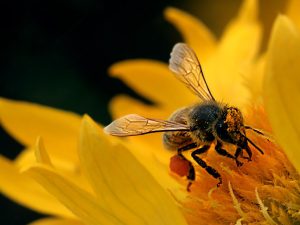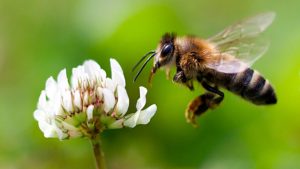 Mnogo različitih vrsta insekata živi na ovoj našoj predivnoj planeti, mnogi su za nas samo štetočine, mnogi nas nerviraju, neki žive totalno van našeg uticaja, a samo je nekolicina koje volimo. Od ovih poslednjih na prste jedne ruke možemo nabrojati one koji su nam korisni. E tu je kraljica insekata na prvom mestu, naša draga pčela.
Mnogo različitih vrsta insekata živi na ovoj našoj predivnoj planeti, mnogi su za nas samo štetočine, mnogi nas nerviraju, neki žive totalno van našeg uticaja, a samo je nekolicina koje volimo. Od ovih poslednjih na prste jedne ruke možemo nabrojati one koji su nam korisni. E tu je kraljica insekata na prvom mestu, naša draga pčela.
Da nema nje skoro da ne bismo bili u mogućnosti da jedemo ni jedno voće – jabuke, kruške, breskve, trešnje, jagode, kupine…. Naime, pčela je ta od koje zavisi nastavak vrste mnogih biljaka, jer ih ona oprašuje, a mnoge biljke bi bez pčela bile osuđene na propast. U tom slučaju čovek bi ostao bez značajnog izvora hrane. Ona nesebično čoveku daruje i sve što proizvede u svom šest nedelja dugom životu. Ali sada par reči o njoj.
Po prvi put, smatra se, pčele se od drugih insekata iz reda Hymenoptera ili opnokrilaca izdvajaju pre skoro sto miliona godina ali ne kao društvene i medonosne pčele već se tada nisu mnogo razlikovale od drugih insekata iz podreda Apocrita. Po prvi put medonosne pčele koje žive u organizovanoj zajednici javljaju se tek pre oko 50 miliona godina od kada datiraju i neki od najranijih fosila. Prvobitna postojbina mnogih vrsta pčela iz roda Apis je Indija i Indokina. Na tom području su se pojavili pretci danas poznatih medonosnih pčela, i to četiri vrste Apis mellifera (ili Apis mellifica) – danas poznata i kao evropsko afrička medonosna pčela, Apis florea – mala indijska pčela, Apiss dorsata – velika indijska pčela i Apis cerana – rasprostranjena u južnoj, centralnoj i jugoistočnoj Aziji. Ovo su medonosne pčele koje danas gaji čovek. Do danas je klasifikovano samo 11 vrsta pčela koje proizvode med.
Iz svoje pra postojbine neke pčele – Apis dorsata, otišle su dalje na istok i naselile Kinu, delove Indije, Indokinu pa čak i Filipine i deo Indonezije. Na teritoriju novog sveta, odnosno Severne i Južne Amerike rod Apis doselio se sa evropskim čovekom. Neki dokazi postoje da su medonosne pčele iz izumrle vrste Apis neartica pre 14 miliona godina naseljavale centralnu Severnu Ameriku a danas područje Nevade.
Nama najznačajnija vrsta, koja je preuzela primat i naseljava skoro sve predele naše planete, te je stoga u užem smislu i zovu medonosna pčela, je Apis mellifica koja je iz svoje postojbine preko male Azije i Egipta dospela u Afriku i Evropu gde je poprimila mnoge osobenosti ali i stekla veoma bitnu osobinu prilagođavanja skoro svim klimatskim područjima. Danas postoji veliki broj podvrsta ove medonosne pčele i neke od najznačajnijih su Apis mellifera mellifera – evropska tamna pčela, Apis mellifera carnica – koja nastanjuje i područje bivše Jugoslavije i Bugarske, Apis mellifera ligustica – italijanska pčela, Apis mellifera iberiensis – pčela sa Iberiskog poluostrva i mnoge druge podvrste karakteristične za Afriku.
Mi smo pčelu upoznali veoma rano, ovladali smo tehnikama uzimanja meda od pčela pre nego što smo zagospodarili ratarstvom i stočarstvom. Prvi dokazi o našem odnosu sa pčelama datiraju 35 hiljada godina unazad, i ovekovečeni su na pećinskim crtežima. U to vreme jedina naša sposobnost bila je da otmemo med tako što bi smo vatrom uništili pčele sakrivene u drvetu, pećini i drugde.
Organizovano uzgajanje pčela počelo je starim Asircima i Egipćanima a taj zanat su kasnije usavršili Grci i Rimljani. U srednjem veku pčelarstvo je bilo veoma cenjeno i najveći pčelinjaci uzgajani su u okvirima manastira i kraljevskim vrtovima i gazdinstvima krupnih feudalaca.
Danas se pčelarstvom iskreno bave samo oni ljudi koji poštuju pčelu i prirodu ali i druge ljude. Bez poštovanja prema pčeli i ljudima niko ne može da postane pčelar već može biti samo medar.
 U jednom pčelinjem društvu na vrhuncu snage, početkom juna može biti i preko 70 000 pčela od kojih svaka ima svoj precizan zadatak. I verujte svaka pčela ne samo da ga u potpunosti ostvari nego i značajno prebaci svoju prirodno zacrtanu normu.
U jednom pčelinjem društvu na vrhuncu snage, početkom juna može biti i preko 70 000 pčela od kojih svaka ima svoj precizan zadatak. I verujte svaka pčela ne samo da ga u potpunosti ostvari nego i značajno prebaci svoju prirodno zacrtanu normu.
Pčela je isključivo socijalno biće i nesposobna je za samostalni život. U društvu po pravilu ima jedna matica koja leže jaja iz kojih se kasnije razvijaju po najviše pčele radilice, trutovi i po koja matica. Svako jaje koje položi matica je isto ali u koju formu će se razviti zavisi od činjenice da li je oplođeno ili ne. Iz neoplođenih jaja se rađaju trutovi a iz oplođenih pčele radilice i matice, a kako će se razviti larva zavisi od hrane kojom pčele hrane larvu koja se formirala iz oplođenog jajeta. Tako ako pčele odluče da zamene maticu larvu hrane matičnim mlečom kako bi se razvila mlada matica. Matica se rodi iz jajeta za 16, dana, trut za 21 dan a pčela radilica za 24 dana.
Matica je najveća pčela i kraljica pčelinjeg društva, u stanju je da tokom godine snese i nekoliko desetina hiljada jaja a sa trutom se sparuje samo jednom u životu i to prilikom svog prvog leta van košnice. Po nekad se u društvu može oformiti i više matica pa se one mogu i sukobiti oko pčela i doma u kojem će živeti. Neke matice uspeju da odvoje deo pčela i napuste društvo u potrazi za novim domom. Na taj način priroda je obezbedila opstanak i proširenje vrste mada je za nas pčelare nekontrolisano rojenje gubitak vitalne snage jednog društva.
Na početku svog života, i to nekoliko dana po rođenju, pčele radilice su zadužene za kućne poslove pa tako tačno u određenim danima svog života proizvode vosak, matični mleč, hrane larve itd. Tako naprimer prva dva do tri dana mlada tek rođena pčela zadužena je za čistoću i grejanje satnih kućica, od 3 do 10 dana pčele hrane leglo i to prvo starije larve a kasnije i mlade. Već u po odmaklom dobu, odnosno od 10 do 15 dana pčele prerađuju nektar, proizvode saće, čiste košnicu i na kraju te faze upoznaju okolinu košnice. Od 15 do 20 dana pčele dobijaju veoma važno zaduženje a to je da čuvaju košnicu od uljeza i time završavaju svoj dugi voni rok. Tek od 20 dana pa negde do 30 – 35 (u zavisnosti od doba godine, inteziteta paše…) pčele rade i samo rade, sakupljaju med i polen. Posle 30 dana ili malo kasnije pčele prestaju sa radom ali ne dobijaju penziju, najčešće lutaju nervozno oko košnice i čekaju sudnji momenat. Mlade pčele radilice umeju da izbace starije pčele iz košnice jer su po njima beskorisne i troše dragocenu hranu. Pčele svoj život završavaju usamljeno na zemlji bez mogućnosti da lete i to nedaleko od košnice.
Čemu služe trutovi, neki bi rekli ničemu pa po njima nazivaju i malo manje vredne primerke naše vrste. Ali da li je to baš tako? Trutovi su veoma bitni za košnicu, i po njihovom broju se može naslutiti snaga i zdravlje pčelinjeg društva. Oni onako veliki doprinose održavanju toplote u košnici posebno legla, doprinose radnom elanu u košnici i posle 12 dana života postaju polno zreli kada su spremni da se oplode sa maticom. Najviše trutova ima u kasno proleće i početkom leta kada je društvo i najjače.
Pčele su jedinstvena bića i umnogome doprinose lancu života i jedinstvu prirode. Čoveku je pčela dar bogova, a mi smo njima usud koji im može i glave doći. Najveći problemi pčela su danas varoa, pesticidi i čovekova nebriga za prirodu. Danas i ubuduće moramo dati maksimum doprinosa za očuvanje prirode i samim tim očuvanju pčela koje su danas ugrožene više nego ikada.
Mi volimo pčelu i činimo sve da joj bude udobno u našem okruženju, a ona nas bogato nagradi svojom ljubavlju.
